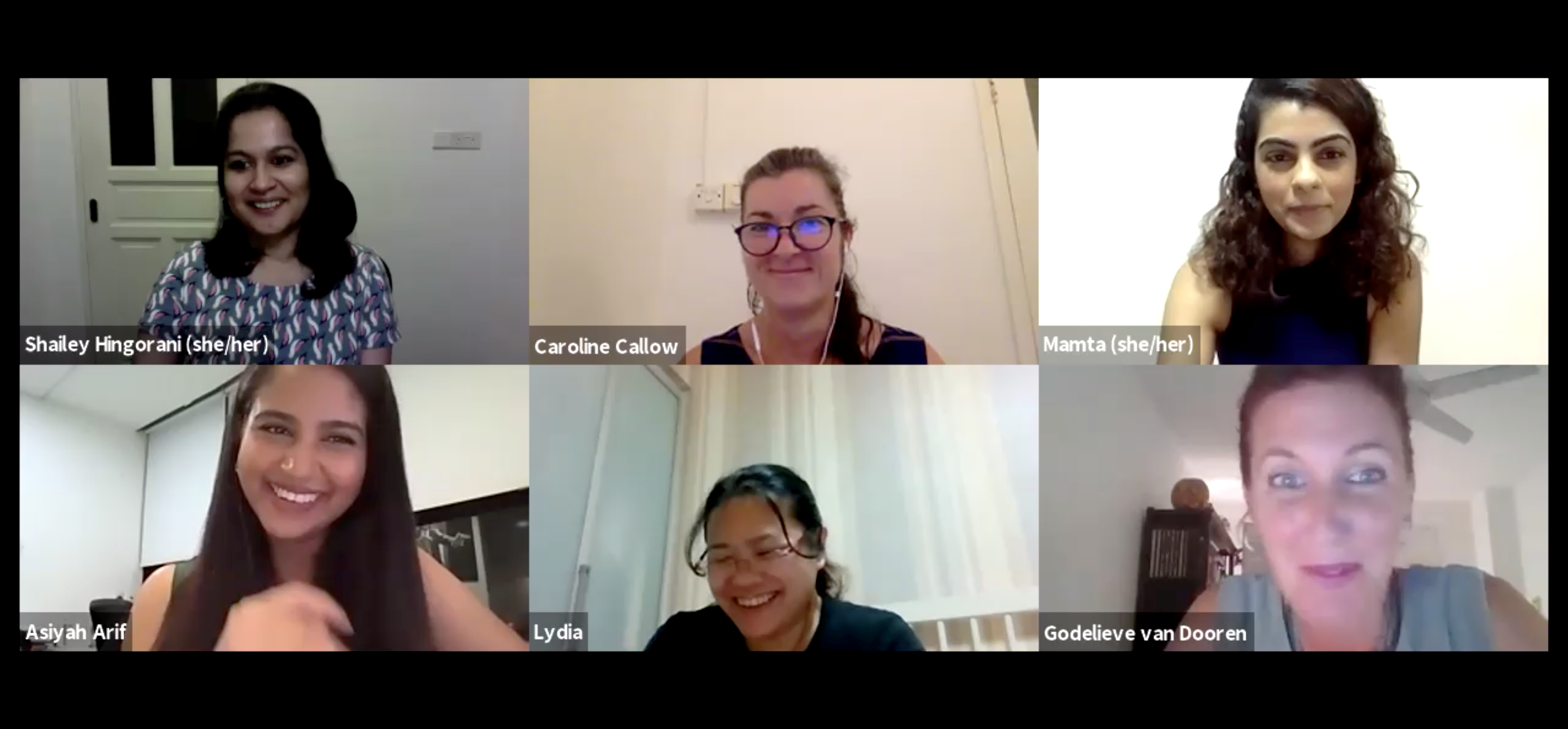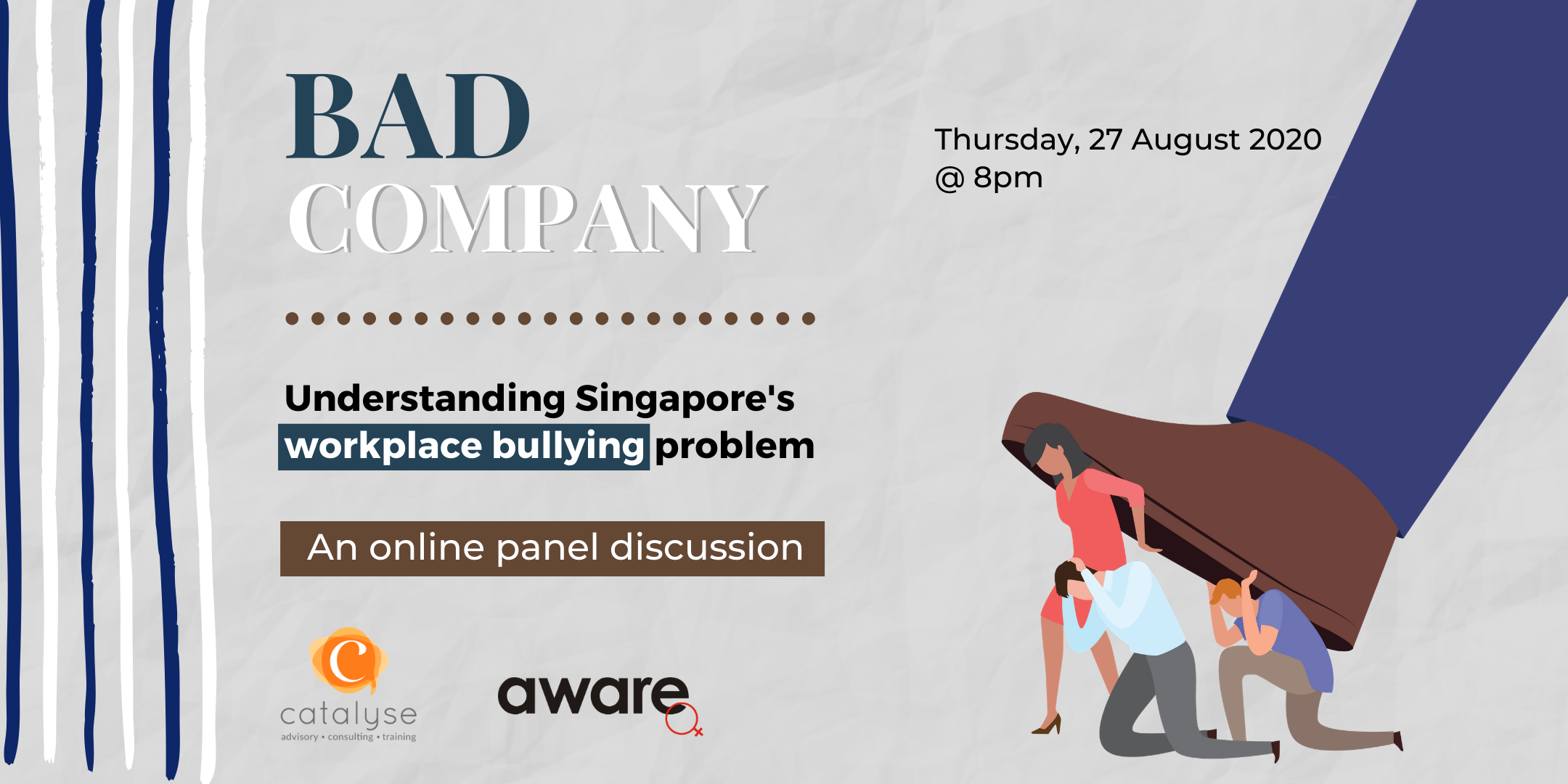-
Advocacy Theme
-
Tags
- Abortion
- Adoption
- Caregiving
- CEDAW
- Disability
- Domestic Violence
- Domestic Workers
- Harassment
- Healthcare
- Housing
- International/Regional Work
- Maintenance
- Media
- Migrant Spouses
- Migrant Workers
- Muslim Law
- National budget
- Parental Leave
- Parenthood
- Polygamy
- Population
- Race and religion
- Sexual Violence
- Sexuality Education
- Single Parents
- Social Support
- Sterilisation
- Women's Charter
A Recap: Bad Company – understanding Singapore’s workplace bullying problem
September 3rd, 2020 | Employment and Labour Rights, News, Workplace Harassment
written by Maia Harrison
The online event Bad Company, which took place last Thursday, 27 August 2020, was a discussion on the pervasive and often ambiguous issue of workplace bullying. Moderated by AWARE’s Head of Research and Advocacy, Shailey Hingorani, it featured an in-depth presentation of the behaviors and impacts of workplace bullying, as well as recourse options for victims.
The event opened with some informal audience poll questions over Zoom. The audience was asked if they had ever been bullied in the workplace, and a surprising majority of respondents—61%—confirmed that they had been bullied. This statistic alone demonstrated the necessity of such an event: Workplace bullying was a tangible issue for many in attendance, not an abstract one.
Caroline Callow, Senior Organisational Development Facilitator and Trainer for Catalyse (AWARE’s corporate consulting and training arm), spoke first. In her presentation, Caroline described the behaviors that constitute workplace bullying, noting that most instances of bullying occur in an ambiguous “grey area” that makes it difficult for victims to gauge the severity of their situation. She also launched a further series of polls, asking audience members to differentiate between rudeness, banter or bullying; chasing for information or intimidation; oversight or exclusion. Audience responses to polls were mixed, confirming that workplace bullying is situational, influenced by social and cultural differences and highly dependent on contextual clues.

The second speaker was Mamta Melwani, Senior Executive for AWARE’s Workplace Harassment and Discrimination Advisory (WHDA). Mamta observed that workplace bullying nearly always reveals itself in a pattern of behaviours, though it can sometimes consist of one single incident. It also occurs within many different relationships—from employee to employee, manager to employee, and employee to manager.
Mamta explained that workplace bullying often overlaps with other discriminatory forms of behavior such as sexual harassment: 55% of discrimination cases seen by WHDA overlapped with workplace bullying. Finally, she gave more information about the services provided by WHDA, as well as the steps individuals can take to build up a strong case against bullying—such as noting down incidents of bullying in a timeline, speaking to advisors for professional and emotional support, and creating paper trails as evidence of bullying behaviours.
Godelieve Van Dooren, a partner at the human resources consulting firm Mercer, spoke next. Her presentation focused on the tangible benefits of diverse and tolerant workplaces. She emphasised that inclusive environments are crucial for business success, because “people want their organisations to do the right thing”: i.e., affinity, pride and emotional purpose are the most important factors for productive employees. The second part of her presentation described best practices for HR, including a culture of zero tolerance of bullying, continuous employee education and thorough investigation of every allegation.
Our final speaker at the event was Asiyah Arif, counsel at Providence Law Asia, who spoke about legal options available to victims reporting workplace bullying. The first, and arguably most important, step is preparation: creating a credible case against an employer. This might involve review of a contract and grievance policy, as well as the compilation of evidence and a preliminary lawyer consultation. Asiyah explained that options for recourse fall under three categories: criminal prosecution, civil remedies or action under the Protection from Harassment Act (as workplace bullying often constitutes harassing behaviour). However, she stressed that no matter what victims choose to pursue, their own personal well-being should be prioritised at every step of the process.
Throughout the event, audience members submitted dozens of questions to the panellists: Did certain environments facilitate workplace bullying? Was there a distinction between gaslighting and workplace bullying? Could workplace cultures in Singapore ever change? Panellists addressed as many of these enquiries as they could. These thought-provoking questions revealed an audience actively engaging with the issues and added nuance and clarity to the discussion.
They also signaled that although workplace bullying is being taken increasingly seriously in Singapore (partially as a result of the COVID-19 pandemic placing a spotlight on the intersection of mental health and work), there is “so much more to do”, as Mamta put it. It’s important that employees and employers alike actively facilitate inclusive workplaces in Singapore, not only to increase productivity, but also to safeguard the wellbeing of all workers.




